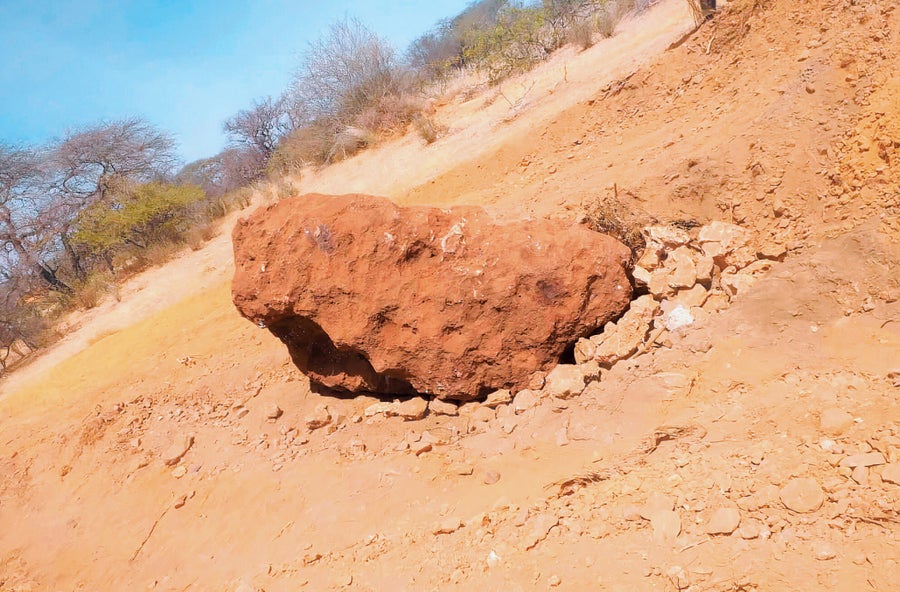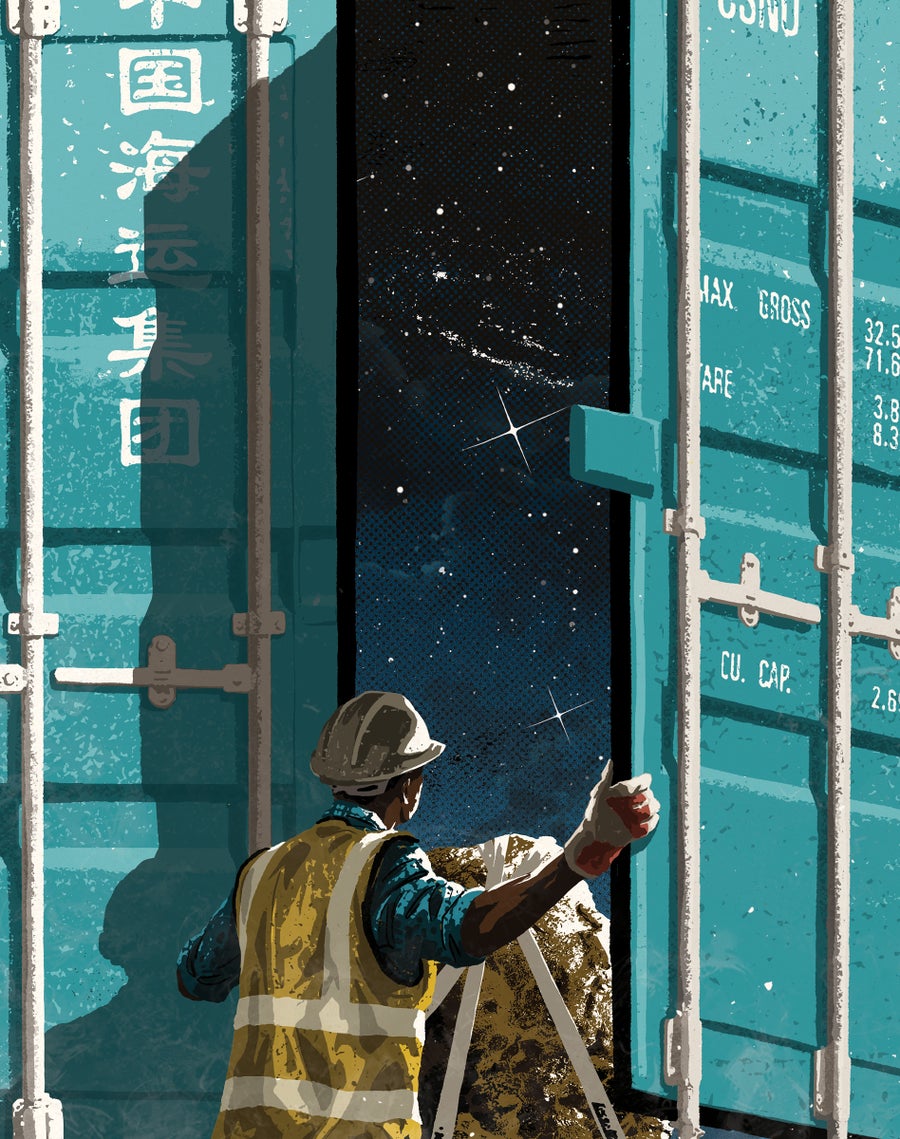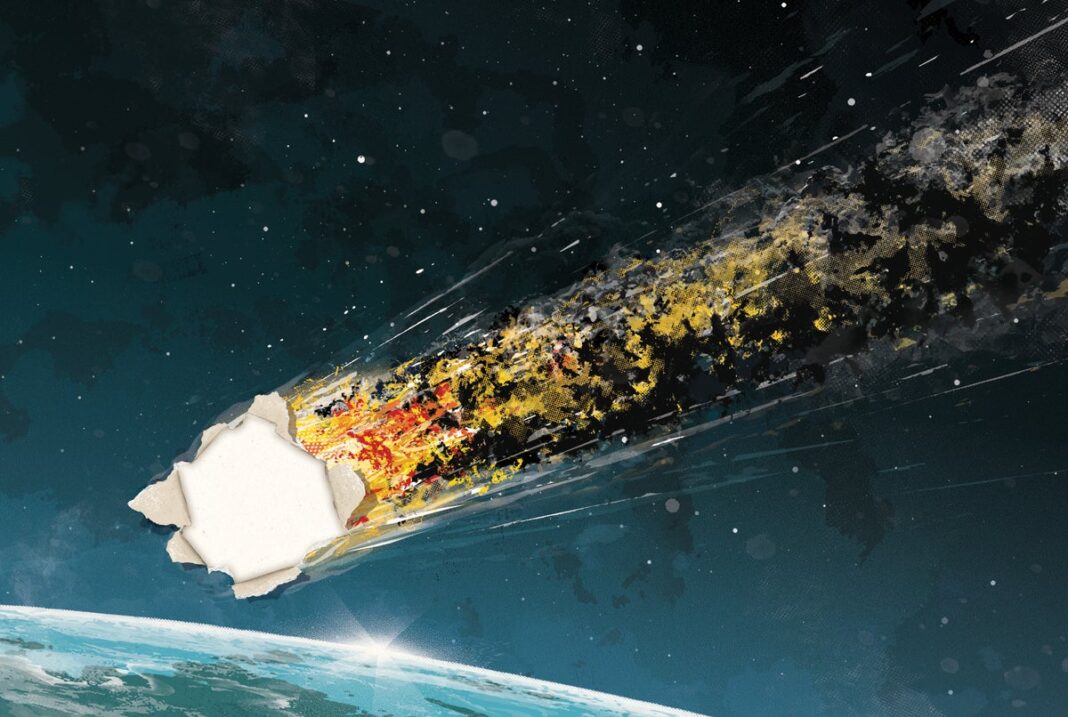Millennia ago a piece of the sky fell toward East Africa, streaking overhead, born of an ancient collision of asteroids. The meteorite landed, probably with more of a thud than a boom, in a river valley where camels now forage near the village of El Ali in Somalia.
Known locally as Shiid-birood (“the iron rock”), the El Ali meteorite is 13.6 metric tons of iron and nickel. For generations it rested in the ground some 24 kilometers (15 miles) outside the village, becoming a landmark that was featured in folklore, lullabies and poems. According to one story, the region had been a green paradise until its inhabitants stopped believing in Waaq, the local god, who punished them with volcanic stones, leaving behind the El Ali meteorite as a reminder of their folly. Over the centuries people hammered the brown rock from the heavens with stones, banging off flakes of cold iron, or used it as a whetstone. Children pretended to ride it like a horse.
Now, though, the El Ali meteorite is gone. Shaky cell-phone videos suggest the rock is being stored in China, where sellers hope to hock it for millions, either whole or in pieces. How did it get there? The journey of the ninth-largest meteorite in the world involves lies, smuggling and possibly death. Mystery surrounds its departure from its landing site, a lawless region of Somalia, one of the poorest and most contested places on the planet. In August, a Somali cultural minister asked the UNESCO World Heritage Center to recognize the meteorite as part of the country’s patrimony, calling for its return in a statement. The fate of the cosmic cannonball is now anyone’s guess.
On supporting science journalism
If you’re enjoying this article, consider supporting our award-winning journalism by subscribing. By purchasing a subscription you are helping to ensure the future of impactful stories about the discoveries and ideas shaping our world today.
For centuries the El Ali meteorite, a brownish, pitted boulder some two meters wide and one meter tall, went unnoticed by anyone but locals. Village elders say that about 80 years ago, during World War II, the Italian army suggested removing it for study. Later, United Nations peacekeeping forces eyed it, and so did militias after the 1991 collapse of Somalia’s government. They were all drawn by the mystery of Shiid-birood, seeing the curious iron rock sitting on the outskirts of a Somali camel-herder village as an object of research—or at least scrap metal. But locals stopped all these extraction attempts. Then, in September 2019, opal hunters scouring the surrounding desert reported the meteorite to a nearby mining outfit—the Kureym Mining and Rocks Company, a Somalia-based firm led by five traders and businessmen in Mogadishu, the country’s capital. Using a hammer, prospectors chiseled a 90-gram sample from the space rock they renamed “Nightfall” and sent it off to Nairobi for analysis. Those samples confirmed for the first time that the meteorite was indeed extraterrestrial, comprising some 44 percent iron and 45 percent nickel.
This is where the story of the El Ali meteorite turns murky—and grim.
We know from news reports and human rights groups that sometime in February 2020, the stone was removed from the village El Ali. The area is largely controlled by al-Shabaab, or “the Youth,” a militant affiliate of al-Qaeda that has been designated a terrorist organization by the U.S. government. Al-Shabaab ruled Mogadishu into the late 2000s but was then dislodged by African Union forces. The organization is responsible for numerous bombings and killings, including the massacre of 148 people at Kenya’s Garissa University in 2015, as well as an “extensive racketeering operation” in Somalia, according to the Council on Foreign Relations. Given the group’s authority in the region, it seems likely that it orchestrated the looting of the meteorite or at least assisted in it.
No one knows exactly what happened after the meteorite was carted out of El Ali, though. News reports from the time say the rock was “forcibly taken” by al-Shabaab. They describe large cranes excavating the stone amid gunfights that reportedly left several people dead, including civilians. Some accounts put the toll even higher, with local leaders describing in news reports two full-scale firefights—one during the dig and one as the meteorite was trucked away—between al-Shabaab and fighters from the clan-based Ma’awisley militia. Some leaders say the fighting included beheadings. But Abdulkadir Abiikar Hussein, a geologist at Almaas University in Mogadishu, calls the reports of bloodshed “exaggerations.”
Whichever way the extraction went down, most accounts agree on what happened next. Militia members drove the meteorite to the nearby town of Buq Aqable, then reportedly sold it to the Kureym mining company for $264,000.
From there the truck carrying the stolen space rock started to make its way toward Mogadishu, but it was detained on the drive. Somalian government officials impounded the vehicle for inspection, Hussein says, after security forces on the road into the city grew suspicious of the big metal boulder in the back of a truck and arrested the lone driver. They sent the meteorite to a warehouse near the local airport. At that point, in late February 2020, the government’s mining ministry called in Hussein. He measured, sampled and tested the meteorite in the warehouse, making the first characterizations of the cosmic rock, which would appear later in scholarly descriptions.
Somehow, however, the meteorite was released. By December 2020 Shiid-birood was back in the hands of Kureym, although the details of the transaction are unclear (Hussein and others say it was corrupt). Kureym representatives declined to comment on the record for this article.

The El Ali meteorite’s original landing site in Somalia is a dry valley without much vegetation.
From “El Ali Meteorite: From Whetstone to Fame and to the Tragedy of Local People’s Heritage,” by Ali H. Egeh, in Meteoritics and Planetary Science; June 12, 2025
Scientists outside Somalia first learned about the meteorite from representatives of the mining company late that year. After Kureym took possession of the stone, Nicholas Gessler, a now retired researcher of anthropology, archaeology and meteorites, got an e-mail about a large meteorite. The sender offered Gessler a chance to study it, saying they were looking for buyers. Piqued by a longtime interest in iron meteorites used by Indigenous people, he agreed to get it analyzed for publication in the Meteoritical Bulletin, a necessity to verify its provenance as a meteorite. Investigating the El Ali meteorite has since called on every one of his areas of expertise, he says, and became an obsession leading him to compile an extensive website tracking the object and what he can piece together of its sordid history. “Nothing is clear,” Gessler says. “People have repeatedly asked for clarity and documentation. None has been provided.”
In January 2021, after Gessler agreed to help register the meteorite, a representative of Kureym sent him a sample. A lump of iron rock, one side weathered brown, the other shining dully from the saw’s incision, arrived in a FedEx package. Around the same time, the company also shipped two sliced chunks of iron rock totaling 70 grams to geologist Chris Herd, curator of the meteorite collection at the University of Alberta.
Both researchers say they wish they had known the full story of the meteorite and its contested ownership at the time. Up to that point, rumors of any violence during its excavation had been confined to Somalian news reports. Only four years later, in June 2025, did a Meteoritics & Planetary Science report by geoscientist Ali H. Egeh of the Somali National University first communicate to the scientific community the “secrecy and uncertainty” surrounding the meteorite and its removal from its home country.
“When I first did the work, I had no knowledge of what had happened, the tragic circumstances,” Herd says. “We were, in retrospect, getting quite biased information” about both the removal of the El Ali meteorite and its export to China. Canadian law, Herd adds, is very strict about the export of meteorites. Temporary loans of samples for study are permitted, but permanent ones are much more sensitive. “For Somalia, this would qualify as having outstanding significance and national importance,” he says. “It is a real shame it has been wholesale exported.”
At the time, Herd and Gessler were simply excited about the opportunity to investigate a meteorite—one that would turn out to be scientifically exciting in several ways. Herd first analyzed his sample with a scanning electron microscope, which shoots a beam of low-energy electrons at solid samples, to view its surface in fine detail. He also used a spectrometer to reveal its elemental makeup. A colleague at the California Institute of Technology employed an electron microscope that used a narrow electron beam with ultrafine 30-nanometer resolution to further analyze the object’s chemistry. Gessler sent part of his sample to A. J. Timothy Jull of the University of Arizona, an expert on dating meteorites, who estimated that it had landed in Somalia 2,000 to 3,000 years ago, based on radiocarbon dating. (Jull cautions that this “very rough estimate” is uncertain and says that other preliminary radionuclide data show that it must have landed 60,000 to 30,000 years ago at the earliest.) Later in 2021 Gessler presented the El Ali meteorite to the Meteoritical Society, recognizing it as the third-largest meteorite discovered in Africa.
Meanwhile, through his correspondence with Kureym, Gessler learned the company hoped to sell the meteorite to a museum for around $30 million. In more than a dozen e-mails, Gessler warned the sales representatives that this plan was unrealistic. But in August 2021 the company’s representatives cut off contact. They complained about his collaboration on the Meteoritical Bulletin entry for the El Ali meteorite with Hussein, the Almaas University geologist who had first measured the meteorite for Somalia’s mining ministry and who was advocating that it be placed in the National Museum of Somalia, not sold.
Still, Gessler and Herd continued to analyze their samples. In 2023 Herd and his colleagues reported that they had discovered three new iron phosphate minerals in the El Ali meteorite that had never been identified as naturally occurring on Earth. “It’s hugely significant scientifically,” says Herd, who classified the meteorite in the type IAB family. Meteorites in this group are likely to have originated in smashups in the asteroid belt between Mars and Jupiter, which created an “almost hard-to-imagine” sea of molten metal magma, Herd says. Born of collisions in space millions of years ago, these cauldrons baked their ingredients together in unusual ways, producing phosphate minerals such as elaliite, elkinstantonite and olsenite (the last two are named after revered meteoritic scientists).

Given that the El Ali samples are only small slivers of a meteorite weighing more than 10 metric tons, “there could be numerous other new minerals within different areas of it,” says Diane Johnson of Cranfield University in England, an expert in ancient iron meteorites. These minerals lace the El Ali meteorite, residing inside tiny inclusions roughly the width of a human hair. “I never thought I’d be part of a study finding new minerals, much less three of them,” Herd says. “The really cool thing is when you do find them, people start to ask whether they exist in other meteorites.” Studying these deposits could reveal new secrets about the chemistry of the early solar system.
The results made a splash in the news and were reported by the BBC, among other outlets. Gessler, at that point invested in the fate of Shiid-birood both professionally and personally, contacted scientists in Somalia. It was then that he first learned about the accounts of bloodshed during its removal. He tried to piece together as much of the story as he could, gathering photographs and videos of the meteorite and posting them on a sprawling website devoted to it. Official representatives of Kureym had stopped communicating with him, but he began to receive text messages from people associated with the sellers, who sometimes sent updates on the meteorite’s sales prospects and even videos showing its move to China. Their recent messages, which he posted at the top of his website in September, have featured bickering between two sellers over prices.
In addition to its value for solar system science, the meteorite could tell us about human history. Gessler is curious about its historic role as a source of cold iron for people in Somalia. The pitted brown lump “has been intensively and extensively hammered,” Gessler says, pounded by generations of people who extracted bits of iron from the rock, probably to make tools such as arrowheads or handles. “It is a really interesting example of Indigenous use of meteorites as a resource by a community,” he says.
The Iron Age in Somalia, he suggests, might have started with the El Ali meteorite.
People across the world have long exploited meteoritic metal. A knife found in the tomb of 14th-century B.C.E. Egyptian pharaoh Tutankhamen was made of meteoritic nickel, iron and cobalt. In the 11th century C.E., followers of the pre-Buddhist Bon religion in Tibet fashioned a statue, thought to be of the Buddhist god Vaiśravana, from a metal-rich meteorite that had landed on the border between modern-day Mongolia and Siberia. A Nazi-backed expedition looted the statue around 1939, and now it’s privately owned by someone in Vienna. The Cape York meteorites are eight large rocks and other fragments weighing about 60 metric tons total that landed on Greenland’s western coast. The Inuit people of Greenland used these rocks to make tools and harpoons. They are the best-known example of Indigenous people exploiting meteoritic stones for iron.
These cases also further demonstrate how commonly meteorites are looted from their original communities. The largest known pieces of the Cape York meteorites, for instance, are long gone from Greenland. U.S. Navy explorer Robert Peary took two of the heaviest ones, the “Dog” and the “Woman,” in 1895, and in 1897 he carried off the biggest one, the “Tent,” which weighed 31 metric tons and was more than three meters across. He sold all three meteorite pieces to the American Museum of Natural History, where they are still displayed, for $40,000—a fortune then—in a Victorian-era example of meteorite treasure hunting and exploitation of Native resources. Peary also convinced six Inuit people to return to New York City with him, where four died of tuberculosis. Another 20-metric-ton fragment of the meteorite was discovered in 1963 and taken to Copenhagen four years later.

A similar story may be playing out with the El Ali meteorite. Its exact location and status now are hazy. In December 2022 the boulder was inside a shipping container on a boat docked at Mogadishu, according to a cell-phone video passed along to Gessler during his sporadic communications with the sellers. After that, it was next recorded in a shaky May 2023 video verifying the meteorite had arrived in China, still under mysterious circumstances. In that video, a speaker talks in Somali, and someone holds up a phone bearing Chinese writing in front of the meteorite. The most recent reports from the sellers and from scientists following the market for meteorites suggest the El Ali object is being held in storage in Yiwu, a midsize city in the Chinese province of Zhejiang, and is being offered for sale in pieces at $200 a gram or at $3.2 million for the entire thing, Gessler says.
“This was a cultural looting operation, not a legal trade,” Dahir Jesow, El Ali’s representative in the Somalian parliament, told the Horn Afrik News Agency for Human Rights in June. The Kureym mining company’s rights to the meteorite were “hastily legalized ad hoc through a murky administrative process—essentially post factum to cover the theft,” he said.
Sales of meteorites by their legal owners are legal, of course, and records of such sales date as far back as 1863, when one was documented in a catalog written by a German collector. Even famous meteorites are regularly bought and sold; a slice of a Cape York meteorite was offered for sale at Christie’s in 2019.
In July 2025 a Martian meteorite retrieved from the Sahara Desert in 2023—reportedly the largest piece of the Red Planet on Earth, at 25 kilograms—sold for $5.3 million to an unknown buyer at auction by Sotheby’s. Niger’s government then announced an investigation into the removal of the meteorite, “which likely bears the hallmarks of illicit international trafficking,” the Nigerian Council of Ministers said in a statement issued the day after the sale. Sotheby’s, however, says it followed all relevant international procedures in the export of the meteorite, including documentation. Like the El Ali meteorite, the Martian rock was described by scholars in a Meteoritical Bulletin entry, this one published in June 2025.
A patchwork of international laws governs such sales. In the U.S., meteorites are owned by whoever owns the land they’re discovered on, and those found on public land go to the Smithsonian. A 1970 UNESCO cultural-artifacts convention recognized by 148 countries, including the U.S. and Canada but not Somalia, outlines a system for tracking meteorites and returning them to their home countries if necessary. But Shiid-birood’s legal status is uncertain: Sharia law currently governs the area it was taken from, but scholars aren’t sure how the law treats meteorites. If UNESCO declares the El Ali object to be part of the cultural heritage of Somalia, as the government has requested, sale of the meteorite would become more difficult.
Within the past five years the market for meteorites has exploded, says criminologist Donna Yates of Maastricht University in Germany, following in the footsteps of the fossil and antiquities trades. “There’s a kind of a profile to that buyer, one that’s very interested in science and space and deep time and so on,” she says. “And those people visit the meteorite market.” The Meteoritical Society has an ethics code requiring researchers to “adhere to laws” in their investigations, but it offers little guidance on exported finds.
China has become a destination for smuggled meteorites in recent years. In 2019 customs authorities seized 857 kilograms of “dolomite” that turned out to be meteorites taken from Kenya, and in 2021 they captured 470 kilograms of iron meteorites listed as pyrite ore in customs declarations. The Kamil impact crater in Egypt was reportedly “strip-mined” for iron meteorites sometime between 2020 and 2023. “There are museums full of stolen stuff,” Jull says.
Both the legal status of the El Ali meteorite and the plans of its current custodians are unclear. “The worry is that it will be ground up a piece at a time to make keychains,” Gessler says. Ideally it would be returned to Somalia. In mid-July, Hussein, the geologist in Mogadishu, heard from members of the Kureym mining company who want to sell the meteorite back to Somalia’s government. The company’s lack of paperwork has stymied sales to international institutions. Only Somalia’s government can make it legitimate, he says, making a return transaction the simplest way for the sellers to turn a profit from the meteorite. The National Museum of Somalia, once a trove of treasured antiquities, was closed for 30 years during the country’s civil war. Although many of its artifacts were damaged or stolen, the museum reopened in 2020, with space for a meteorite display under a reinforced stand. “University students and children from even elementary schools would come to see it,” Hussein says. He envisions international researchers collaborating with local university students to build expertise in geochemistry in Somalia. “Now we’ll have to raise the money.”
Even if the meteorite does come home, its safety isn’t guaranteed. Dalmar Asad, a spokesperson for the Coalition of Somali Human Rights Defenders in Mogadishu, is skeptical that his country can protect Shiid-birood if it returns to Somalia. Security is still very uncertain, he says, even in Mogadishu. He worries that local misunderstandings about the meteorite—some early news reports suggested it was made of gold—might prompt someone else to attempt to steal it, even from the museum. “I think it would be better for an international organization to host the meteorite until the situation here is more secure,” he says.
For now the El Ali meteorite remains in limbo very far from home. Its ultimate destination is just as uncertain as it was when it was in the asteroid belt, bouncing across the sky. Wherever it ends up, though, this piece from the heavens may impart lasting lessons on Earth. The meteorite’s tale should teach scholars to ask harder questions about the provenance of newly reported discoveries, says planetary scientist Hasnaa Chennaoui Aoudjehane of the Hassan II University of Casablanca in Morocco. “This community is my community; many scientists are friends of mine,” she says. “But in some cases, we are just closing our eyes. We don’t want to take on the reality of the problem because if we do, there will be much less material to study.”





